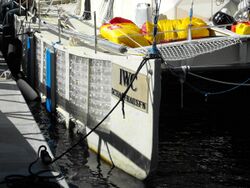Plastiki
Topic: Engineering
 From HandWiki - Reading time: 4 min
From HandWiki - Reading time: 4 min
 Plastiki on display at the Australian National Maritime Museum following her Pacific crossing
| |
| History | |
|---|---|
| Name: | Plastiki |
| Owner: | David de Rothschild |
| Builder: | Andy Fox, San Francisco |
| General characteristics | |
| Type: | Catamaran |
| Tons burthen: | 12 tons |
| Length: | 60 ft (18 m) overall |
| Beam: | 23 ft (7.0 m) |
| Notes: | 12,500 PET bottles used as flotation[1] |
The Plastiki is a 60-foot (18 m) catamaran made out of 12,500 reclaimed plastic bottles and other recycled PET plastic and waste products.[2] Michael Pawlyn[3] of Exploration Architecture worked on the concept design with David de Rothschild and helped to shape some of the key ideas. The craft was built using cradle to cradle design philosophies and features many renewable energy systems, including solar panels, wind and trailing propeller turbines, and bicycle generators. The frame was designed by Australian naval architect Andrew Dovell. The boat's name is a play on the 1947 Kon-Tiki raft used to sail across the Pacific by Norwegian explorer Thor Heyerdahl, and its voyage roughly followed the same route.[4]
On March 20, 2010, the sailing vessel set off from San Francisco , California to cross the Pacific Ocean with a crew of six: British skipper Jo Royle, co-skipper David Thompson, expedition diver Olav Heyerdahl, filmmakers Max Jourdan and Vern Moen, and expedition leader David de Rothschild.[5] The expedition projected landfall in Sydney, Australia and included plans to visit several sites en route of ecological importance or which were susceptible to environmental issues caused by global warming, for instance the current sea level rise, ocean acidification and marine pollution.
Plastiki arrived in Sydney Harbour on July 26, 2010, accompanied by a small flotilla of boats.[6] Shortly afterwards, it was towed to the Australian National Maritime Museum in Darling Harbour, where it was on display until late August.[4]
Documentary
The documentary following the story of Plastiki and the state of the world's plastic use was titled Plastiki & the Material of the Future.[7] Although never widely released, it screened at Mountain Film Festival in Telluride, Colorado.[8] According to the production company's website the aspect of the film that had to do specifically with plastics has been re-edited and named simply The Material of the Future and premiered at the Friday Harbor Film Festival in Washington on November 7, 2014. There has been no official announcement as to why the film has been separated from the Plastiki.[9]
See also
- Nice Collective
- Junk raft
- Project Kaisei
- Great Pacific Garbage Patch
References
- ↑ "Plastiki FAQs". theplastiki.com. Adventure Ecology. 2010. Archived from the original on January 25, 2011. https://web.archive.org/web/20110125213412/http://www.theplastiki.com/faqs/. Retrieved January 16, 2011.
- ↑ "The Plastiki - Behind the Scenes" (PDF) (Press release). Adventure Ecology. 2010. Archived from the original (PDF) on July 17, 2011. Retrieved October 12, 2010.
- ↑ Etherington, Rose (July 22, 2010). "Dezeen". Dezeen. https://www.dezeen.com/2010/07/22/plastiki-expedition-boat-by-exploration-architecture-for-adventure-ecology/.
- ↑ 4.0 4.1 Barry, Carolyn (July 27, 2010). "Plastiki sails into Sydney Harbour". Australian Geographic. Archived from the original on November 20, 2010. https://web.archive.org/web/20101120153329/http://australiangeographic.com.au/journal/plastiki-sails-into-sydney.htm. Retrieved August 6, 2010.
- ↑ "The Plastiki Crew". theplastiki.com. Adventure Ecology. 2010. Archived from the original on December 22, 2010. https://web.archive.org/web/20101222021649/http://www.theplastiki.com/crew/. Retrieved October 12, 2010.
- ↑ "Plastiki reaches Sydney after 8000 mile sail". Australian Sailing magazine. Yaffa Publishing Group. July 26, 2010. Archived from the original on April 10, 2011. https://web.archive.org/web/20110410173238/http://www.mysailing.com.au/news/plastiki-reaches-sydney-after-8000-mile-sail. Retrieved January 16, 2011.
- ↑ "Official Website of the documentary of the Plastiki's Voyage". http://plastikithemovie.com/.
- ↑ "MOUNTAINFILM IN TELLURIDE ANNOUNCES WORLD PREMIERES". May 1, 2012. http://www.mountainfilm.org/2012/05/01/mountainfilm-in-telluride-announces-world-premieres.
- ↑ "Long Beach Film Company's Website". http://longbeachfilmcompany.com/c/projects/.
External links
- CNN special coverage page
- "Adventurer's bottle boat to sail plastic sea". Times Online. Retrieved on 2009-01-18.
- Here On Earth: Radio Without Borders, April 20, 2009
- Sundance Channel: ECO TRIP - About David de Rothschild
- John Colapinto, “Message In a Bottle,” The New Yorker, April 6, 2009
- Plastic Boat: The Building of a High-Tech Eco-Stunt, Wired, Nov. 16, 2009
- "Boat made of plastic bottles sets sail across Pacific" BBC 21 March 2010
- National Geographic Adventure blog
- Plastiki Sails Into Sydney - slideshow by Life magazine
- L2 Industries - Materials, engineering, and production of the vessel
- Seretex - The material of The Plastiki
 |
 KSF
KSF
